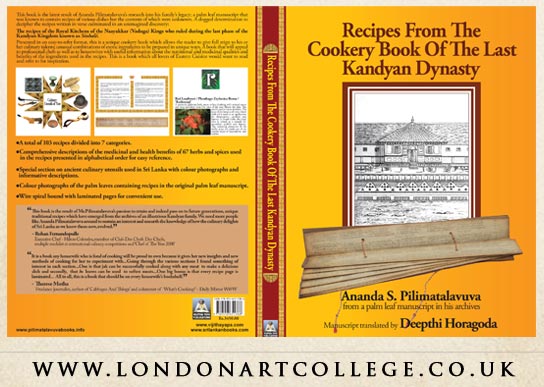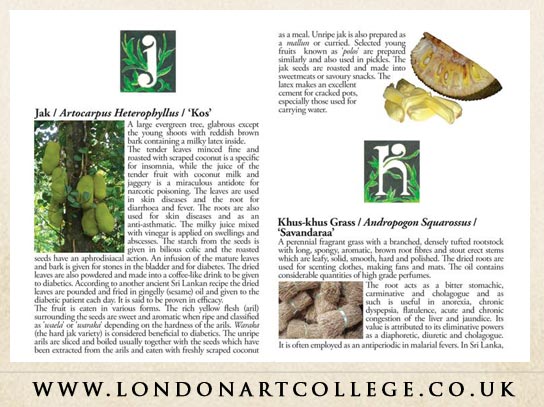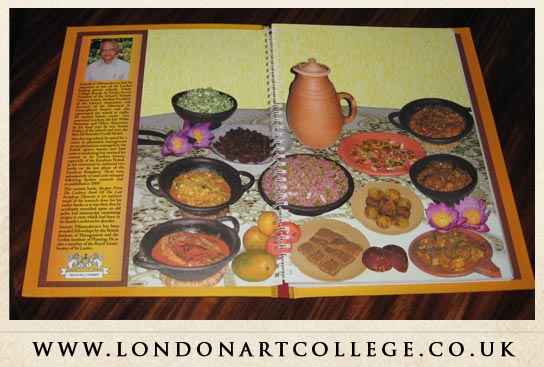Recipes From The Cookery Book Of The Last Kandyan Dynasty
One of our Graphic Design students has been working on a fantastic project to help collate a cookery book from old manuscripts used by the last Royal Dynasty in Sri Lanka. From gathering all the information, translations, designing, organising to the final product which you can see images of below, Deepthi has written the full story for us below. She explains how the London Art College Graphic Design course helped her during the process which is wonderful news. I hope you enjoy reading about Deepthi’s experiences and find it an inspiration.
——————————————————————————————————————–
My role in the creation of the book and how the LAC Graphic Design Diploma Course helped me.
When the author of the book casually asked me one day whether I could scan some old palm leaf manuscript leaves for him, I had no idea it would lead to the publication of a book, let alone the cookery book used in the palace of our last royal dynasty! That was the beginning of a journey which took almost 3 years and many sleepless nights. It saw me wearing many hats, first trying my hand at transcribing the words and typing them in Sinhalese (the native language) and translating the text which was in verse right throughout. The translating was an on and off affair, as the text contained many confusing and sometimes misspelled obsolete words. Apart from that, I had to attend to it during my free time. As a whole, it was the translating of the original text that took the longest time to complete. Another challenge was finding the botanical and common English names of the many spices and herbs found in the text. Fortunately, the internet and a dedicated Sri Lankan scholar living half a world away in Canada came to our rescue! Having gathered the relevant information for inclusion in the special appendix from the internet I forwarded the results to the author and got onto planning the page layout and design aspects…
This is where what I learned by way of typography from my late mentor Mr.Gareth Jayawardene came into play together with what I had learned from the LAC course. Looking back I think I can truly say that the LAC course contributed much to the final design of the book as the course made me go back to the true essence of my craft — drawing by hand. Inspired by some material I was reading by way of additional reference for my course I decided to design a set of illustrated drop initials to be used in the appendix of the book. In order to guage their effectiveness I posted some other similar work done by me on the LAC Student’s Forum and was very encouraged by the comments of my fellow students — even those following other courses wrote in commending my work. I owe them all a big thank you! The section titles, we had decided early on our journey, would imitate the palm leaf manuscript leaves. However, fonts imitative of cursive writing looked too sophisticated when compared against the original manuscript writing done 2 centuries ago using a stylus.
Here again, my LAC course inspired me as we have a section on calligraphy in our course materials. So I set myself the task of becoming reasonably good in the foundation hand in order to write not too sophisticated-looking section titles. Having bought a set of calligraphy pens early on during the course I was feeling confident of learning calligraphy until I found that the pens were defective. After much trouble I was finally able to obtain a set of Manuscript dip pens and calligraphy ink from Singapore. Having ordered a book on calligraphy from the USA which also inspired us to go in for a similar hidden wire spiral binding for our cookery book, I had to really get on with it and get on I did until I found that the paper I used for writing tended to bleed and would not reproduce well once scanned! On the verge of ordering parchment paper from abroad which would have delayed our work further I tried my hand at a sheet of coated paper from a packet which I had got a few years back. To my utter amazement I found that I could write flawlessly on coated paper and once scanned in, it was very easy to make any further adjustments on the computer. If there is one thing I learned from that experience, its that sometimes the most unlikely material can perform as well as more expensive ones and everything is worth a try.
I also had the opportunity to photograph at the Colombo National Museum the ancient culinary utensils and other objects featured in the book. After 2 hours and 20 minutes I had as many photographs taken. The difficult part was editing them to eliminate the glass cabinets in which the items are displayed and also enhancing the brightness and details of the objects. However, I think it was worth the effort, judging by the appreciative reaction we have had from readers who have commended us for including these images and offering the younger readers a chance to learn about the life-style of a former era.
I am very fortunate that the author of the book gave me complete freedom to try out various design possibilities. To his credit it must be stated that he didn’t turn down any suggestion as outlandish, encouraging me to experiment and innovate. This book is also proof of how the internet has made it possible to collaborate and create work which otherwise would have been far too expensive and time consuming; the author and I live 65 miles apart and if not for PC calls on Skype, our telephone bills would have been huge. In fact, if not for the internet I wouldn’t have known about the LAC, let alone enroll for the Graphic Design Diploma Course!
The book has been reproduced by Mr.Ananda S. Pilimatalavuva from a manuscript in his family’s archives and published by Vijitha Yapa Publications, Sri Lanka. Translating the recipes into English from the original manuscript, book cover and page layout and design, type-setting and illustrating by Deepthi Horagoda.
The source of the book
The source of this unique book is a hand-written copy of the cookery book used in the royal palace in the Kingdom of Kandy, Sri Lanka’s only independent region after the British invasion of 1796. Until the introduction of paper to Sri Lanka by Western colonialists, all books were hand-written on dried palm leaves or in the case of very valuable royal decrees or religious texts, on thin sheets of precious metals such as gold, silver or copper. The manuscript which is the source of the book under scrutiny was in the possession of the author’s family, being descendants of the chief minister at the royal court. Research has revealed the existence of 6 copies of the manuscript, out of which one was in the possession of the descendants of the lineage of royal chefs, another copy is at the library of the University of Copenhagen, having been taken to the Netherlands by the Dutch invaders and yet another is housed at the London Museum after the Kingdom of Kandy was ceded to the British in 1815. The copy of the manuscript in the author’s possession was probably written in the late 18thcentury or early 19th century. Another interesting feature about the original manuscript is the fact that the entire text (including the recipes) are written in verse.
Contents of the cookery book
We found 103 recipes in the original manuscript which we re-arranged under 7 categories in our book for ease of reference. Apart from the recipes, the manuscript also contained information about the medicinal properties of the ingredients. This is because unlike today, in the past, food was also considered as a source of healing by using herbs and spices with medicinal value in the preparation of meals. While many of the spices are still used in our native daily cooking, their importance is unknown to the younger generations. Therefore, we felt it was our duty to include this information as a separate section in our book for easy reference. Hence, an appendix containing the medicinal properties of 67 spices and herbs used as ingredients in the recipes. However we decided to provide our readers with as much up-to-date information as possible and the result is a collection of universal wisdom gathered from various reference books as well as from the internet. Interestingly, we discovered that one of the ingredients used liberally in the recipes, namely asafoetida, contains natural antiviral drug compounds that kill the swine ‘flu virus. In order to create and preserve an awareness of a lesser known aspect of our heritage we have included photographs of 60 culinary utensils and equipment used in households in the past, as well as a range of equipment and pill boxes used by native physicians. We have also photographed and included the tools used to create palm leaf manuscripts like the original manuscript of the cookery book as well as some other books and covers made of precious material and which are on display at the National Museum in Colombo.
Source of the design motifs used in the book
We felt that it would be best if we included a photograph of the original recipes on the page which contained those particular recipes, so that there would be no room for doubt as to the authenticity of the contents. Once this decision was taken, it became clear that we needed some sort of decorative motif to make the pages visually appealing and to enforce some form of cohesion. I felt that something from the same style and technique as the palm leaf manuscript would be best. This meant that I would have to find some samples of traditional palm leaf manuscript art to use as a source. Fortunately I recalled that my horoscope chart drawn in traditional style on a palm leaf manuscript had some nice designs on it. I scanned the various designs and digitally altered them as needed to re-create the required elements for the book.
Additional links to book
More information about the book can be read on the author’s website at www.pilimatalavuvabooks.info The book can be purchased online from the publisher’s online bookshop at www.vijithayapa.com




This is a wonderful achievement Deepthi. Having read your summary of the process behind getting this book into production I can really appreciate the hours you have put into making this collection of recipes and culinary information accessible to a wider audience. It is fascinating to read your account of the many aspects of the book that you were involved with. I am pleased that you were able to utilise the skills from the Art in Graphic Design course in the design of this book. It was well worth the hard work. A terrific addition to your portfolio, congratulations!